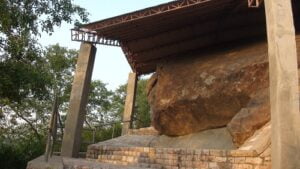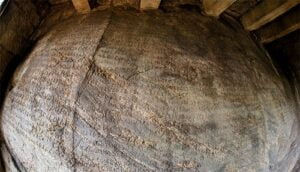After witnessing the terrible effects of the Kalinga war, the Mauryan Emperor Ashoka decided to be peaceful and follow the dharma (righteousness). He started promoting Buddhism and wanted everyone to know about it. And, the Rock Edicts of Ashoka collectively is such a historical record that documents his moral policies, teaching, reflections on his governance, and much more.
The Edicts of Ashoka are a collection of over thirty inscriptions found on Pillars, Rocks, and Caves. But today we take the rock edicts only. This article will provide you with detailed insights into the Rock Edicts of Ashoka.
Location:
Ashoka’s rock edicts are spread across India, Pakistan, and Afghanistan, divided into two categories- Major Rock Edicts and Minor Rock Edicts. The major rock edicts were strategically placed on the frontiers of Ashoka’s empire, rather than the central region of Bihar. The places include the parts of today’s Andhra Pradesh, Gujrat, Odisha, Uttarakhand, Maharashtra, and many more. This reflects the King’s aim to convey his policies and moral principles to diverse populations in the surroundings of his territory.
In contrast, the traditional minor rock edicts of Ashoka are mainly found in Central and Southern India. The places include parts of today’s Karnataka, Andhra Pradesh, Madhya Pradesh, Rajasthan, Bihar, and many more.

Apart from these, some miscellaneous inscriptions in Aramaic or Greek are found in Pakistan and Afghanistan.
A Brief Description of Ashoka’s Rock Edicts:

Among the mentioned two categories, the minor rock edicts are from the earlier time (269-233 BCE approx), and also are Ashoka’s first edicts in any Indian language. These are in Prakrit language and use Brahmi script. Additionally, they follow Ashoka’s first known inscription (from 260 BCE approx), named Kandahar Bilingual Rock inscription, written in classical Greek and Aramaic languages. Notably, the inscriptions in Greek or Aramaic are also often referred to as Minor Rock Edicts of Ashoka.
On the other hand, the Major Rock Edicts refer to a collection of 14 rock edicts of King Ashoka. These are written in three languages. Among those, the edicts, written in the oldest Prakrit language, use Brahmi and Kharoshthi script. However, in the area of Pakistan, the inscriptions use the Kharoshthi script. Other edicts are written in the Greek and Aramaic languages. These edicts are usually carved on big rocks, except the Kandahar Greek Edict. Notably, the Kandahar Greek Edict probably contained all Major Rock Edicts 1-14.
Facts Mentioned In Major Rock Edicts of Ashoka:

These edicts are among the most thorough and detailed inscriptions of Ashoka. The edicts mirror the King’s views on morality, social justice, and more, while also expressing his role as a ruler. Here, we mentioned some important points of them:
Care for Animal Life:
The King started his first major rock edict by emphasizing respect for animal life. He says that no living being should be sacrificed. Additionally, he acknowledged that once he also killed many animals for food. But, later he decreased the number to three and planned to stop even this.
Medical Care & Other Facilities:
Various facilities like providing medical services, herbs, and fruit plants were offered by the Ashoka’s administration. Furthermore, it extended beyond humans, providing benefits to animals as well. King Ashoka set up different medical facilities for Humans and cattle. Additionally, he ensured the availability of needed herbs, roots, and fruits. He imported them to areas where they were lacking. To enhance the well-being of both people and animals, he planted trees along roads and dug wells as well. Notably, the people in neighboring regions were also not deprived of the services.
Societal Well-Being & Moral Teaching:
The edicts also emphasize the King’s concern for moral teachings and societal well-being. It includes highlighting the importance of obedience to parents, generosity towards different groups, abstaining from killing animals, and so on. It also states that there was a lack of respect for relatives, Brahmanas, and Sramanas, in the past times. But, in later times, King Devanampriya Priyadarsin brought positive changes through his moral leadership. People were encouraged to be kind, show respect to family, and religious figures, and avoid harming others.
Ashoka’s Commitment to Welfare:
Emperor Ashoka appointed Mahamatras of morality to promote and establish moral values among different communities, including prisoners and the destitute. Additionally, he wanted to be informed about people’s affairs anytime, anywhere. According to the edicts, the King expected prompt reports of disputes or amendments to address them effectively.
The Moral Tour:
The Major Rock Edict 8 is one of the important edicts of Ashoka, as it holds the record of the King’s visit to Sambodhi. This place, also called Bodh Gaya, is the place where Lord Buddha attained enlightenment. According to the King Ashoka, it was a tour of morality. During this tour, he engaged in positive activities like meeting Sramanas and Brahmanas, giving gifts, supporting the elderly with Gold, and teaching morality to the people. This marked a more virtuous and joyful phase of his reign.
Note for the upcoming rulers:
At the end of the major rock edicts, King Devanampriya Priyadarsin offers guidance to future rulers. After regretting the loss of life in the conquest of Kalinga, he focuses on moral principles. From then on, he prioritized morality over aggressive conquests. His messages emphasize kindness, self-control, and the far-reaching impact of moral leadership. Thus, through his edicts, the King advises upcoming rulers to prioritize morality for lasting success.
About Two Separate Major Rock Edicts:

Two separate rock edicts of Ashoka are present in Dhauli and Jaugada, the region under Ashoka in Kalinga. They are also part of present-day Odisha. Notably, the chronology says that the first one is engraved after the second one. But, both are from around the same time as the other 14 major rock edicts of Ashoka. These edicts mainly address the local officials of Tosali (in the Dhauli separate edicts) and Somapa (in the Jaugada Versions).
Among these, the first separate edict instructs the mentioned officials to establish a fair judicial system and implement Ashoka’s control through Mahamatras from Pataliputra, Ujjain, and Taxila. The second one asks them to persuade unconquered bordering tribes about the King’s benevolent intentions.
Facts Mentioned In Minor Rock Edicts of Ashoka:
The minor edicts play a crucial role in confirming and recording that ‘Devanampriya Priyadarsin’ and Ashoka are the same person. The Maski version confirms Ashoka’s association with the title ‘Devanampriya’, while the Gujarra minor rock edict addresses Ashoka as ‘Devanampriya Piyadasi Asokaraja’.
Usually, the edicts on Rock 1 and Rock 2 are compiled. In Rock 1, Emperor Ashoka addresses himself as an Upasaka of Buddha (Buddhist Layman). Besides, the edict states that Ashoka is getting closer to the Sangha and has become more devoted to his faith. Notably, the minor rock edict no. 3, which appears only in front of Bairat Temple in today’s Rajasthan, is now in Calcutta’s Asiatic Society Museum. This edict shows Ashoka’s deep reverence for Buddha, Dharma, Sangha, and provides a list of Buddhist scriptures for monks and the laity to study.
Moreover, the rock edicts of Ashoka play a vital role in connecting Buddhism with the governance principles of the notable ruler of Ancient India. They express the influence of Buddhism on Ashoka’s principles. Also, it collectively provides the details about Ashoka’s rule, moral values, his dedication to non-violence and social welfare. Thus, the edicts are one of the important records that helped a lot in shaping the history of ancient India.
Frequently Asked Questions
Welcome to our FAQ section, where we address common queries and provide insightful answers to enhance your understanding. If you can’t find what you’re looking for, don’t hesitate to reach out to us.
Ashoka’s rock edicts are spread across India, Pakistan, and Afghanistan, divided into two categories- Major Rock Edicts and Minor Rock Edicts. The major rock edicts are placed on the parts of today’s Andhra Pradesh, Gujrat, Odisha, Uttarakhand, Maharashtra, and many more.
And the traditional minor rock edicts of Ashoka are mainly found in the parts of today’s Karnataka, Andhra Pradesh, Madhya Pradesh, Rajasthan, Bihar, and many more.
Two separate rock edicts of Ashoka are present in Dhauli and Jaugada, the region under Ashoka in Kalinga. They are also part of present-day Odisha.
Two separate rock edicts of Ashoka are present in Dhauli and Jaugada. The chronology says that the first one is engraved after the second one. But, both are from around the same time as the other 14 major rock edicts of Ashoka. These edicts mainly address the local officials of Tosali (in the Dhauli separate edicts) and Somapa (in the Jaugada Versions).


Admiring the timme and energy you put into your website and detailed information you offer.
It’s awesome to come across a blog every once iin a while that isn’t the same oldd rehashed information. Fantastic read!
I’ve bookmarked your sie and I’m adding your RSS feeds
to my Google account. https://www.Waste-ndc.pro/community/profile/tressa79906983/
Thank You Very Much.. It means a lot.. 💖 💖 💖
Admiring the time and energy you put into your
website andd detailed information you offer. It’s awesome to
come acrolss a blog every once in a while that isn’t the same old rehashed information. Fantastic read!
I’ve bookmarked your site and I’m adding your RSS feeds to my Google account. https://www.Waste-ndc.pro/community/profile/tressa79906983/